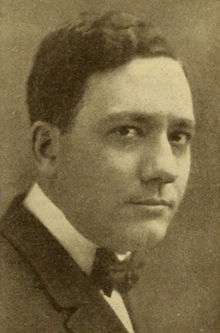Terry Ramsaye
| Terry Ramsaye | |
|---|---|
 1916 Photo from Moving Picture World | |
| Born |
November 1, 1885 Tonganoxie, Kansas, USA |
| Died |
August 19, 1954 (aged 68) Norwalk, Connecticut, USA |
Terry Ramsaye (2 November 1885, Tonganoxie, Kansas - 19 August 1954, Norwalk, Connecticut) was a film historian and author of A Million and One Nights: A History of the Motion Picture [Through 1925] (New York: Simon & Schuster, 1926).
Biography
Ramsaye started his professional career as an engineer but switched to journalism when he joined the staff of the Kansas City Star and Times in 1905. In the following decade, he worked on newspapers in Leavenworth, Kansas, and in Omaha, St. Paul, Minnesota, and Chicago.
The motion picture industry was in its infancy when he joined Mutual Film Corporation in 1915. While at Mutual, he produced some Charlie Chaplin comedies and founded Screen Telegram, which achieved conspicuous success during World War I. He was one of the founding members of the Associated Motion Picture Advertisers.[1]
Subsequently he was associated with Samuel Roxy Rothafel in the management of Broadway's Rialto and Rivoli theaters. He also launched and edited the newsreel Kinograms. After producing and editing numerous adventure films including Grass (1925) and Simba: King of the Beasts (1928) with explorers Martin and Osa Johnson, he became editor-in-chief of Pathé News and Audio Review.
In 1931, Ramsaye joined the Quigley Publishing Company as editor of the Motion Picture Herald, a post he held until 1941. Subsequently, he lectured on motion pictures and contributed articles to various encyclopedias and year books. He continued his association with Quigley as consulting editor and author of a weekly column for the Herald until his death in 1954.[2]
Thomas Edison's endorsement is included in the book.[3] H. L. Mencken spoke highly of it.
References
Notes
- ↑ "Movie Ad Men in Association" (1171). The Fourth Estate. August 5, 1916. p. 12. Retrieved 2014-02-15.
- ↑ Ramsaye, "About the Author" (last page).
- ↑ Ramsaye, first page.
Sources
- Ramsaye, Terry. A Million and One Nights: A History of the Motion Picture (Abingdon, UK: Frank Cass, 2012) [original edition: New York: Simon and Schuster, 1926]. Pages not numbered.